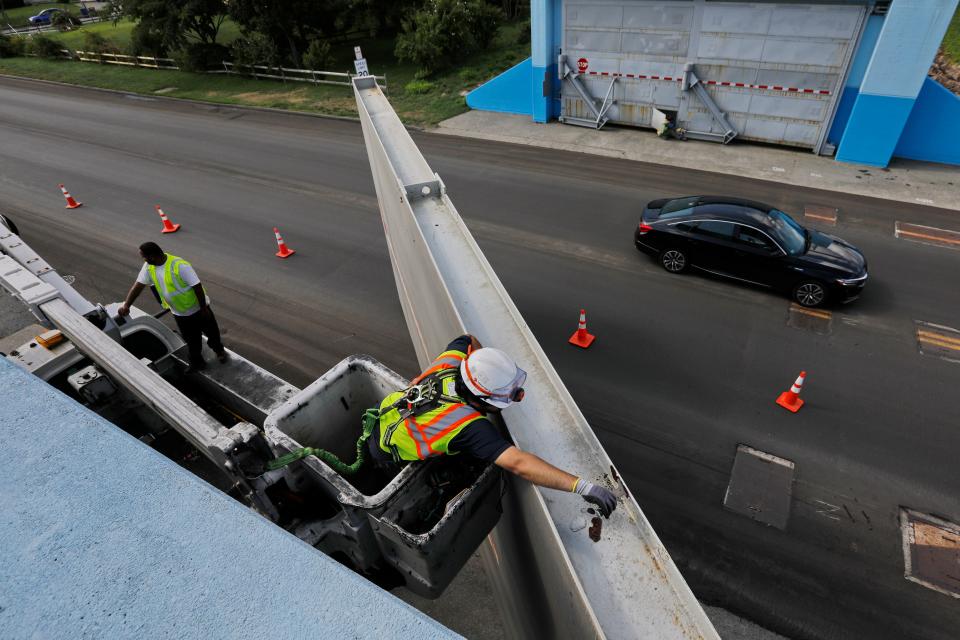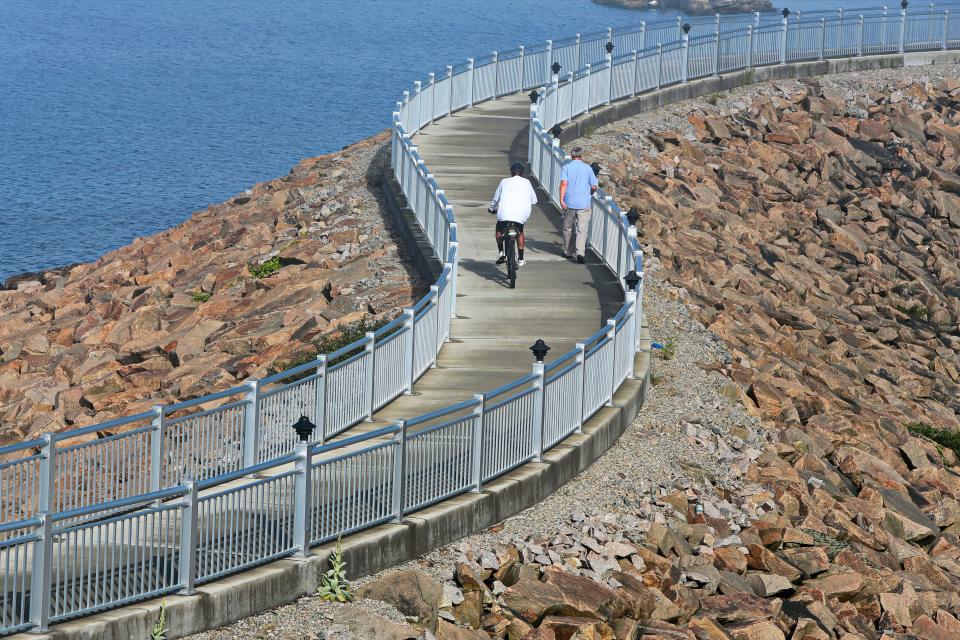'Waiting for the ultimate test': What to know about the New Bedford Hurricane Barrier
NEW BEDFORD — Fifty-five hurricane seasons have passed since the New Bedford Hurricane Barrier opened for business in 1966.
It took four years of construction involving almost one million man-hours of work fashioning 900,000 or so tons of granite into the approximately 18,000-foot-long insurance policy against tidal flooding associated with hurricanes and coastal storms.
It's known as the largest man-made stone structure in the Eastern United States, as well as the largest hurricane barrier on the East Coast.
Now in its 56th hurricane season, the barrier is in fine fettle, having undergone routine inspections and maintenance repairs earlier this year.

The United States Army Corps of Engineers is required to conduct a "dewatering" of the barrier every eight to 10 years. That allows the Corps to thoroughly inspect the areas behind the sector gates that are normally hidden below the water level, as well as complete a variety of maintenance repairs, according to a press release.
In this latest checkup, the USACE also replaced wheels along the sector gates and painted barrier structures to prevent corrosion.
The New Bedford Dept. of Public Infrastructure has also performed its annual maintenance chores. DPI Commissioner Jamie Ponte said the barrier is split up into three segments, New Bedford's segment, the Army Corps' segment, and Fairhaven's, with each responsible for its portion's maintenance.
"We maintain and exercise the street gates. We make sure there's no encroachments or growths along the hurricane barrier itself. There are some salt water intakes that run under the barrier. We have to inspect them for their integrity. And then we maintain the pumping station that's built into the barrier," he said.
He added that DPI also educates and trains staff in gate and pumping station operation. "We try to keep a lot of the same staff involved but we do mix in folks considerably to make sure enough people know operations in case of an emergency if somebody's out of town."
Ponte said, "As of right now, everything is in good condition. The Army Corps is pleased with New Bedford's efforts. We're in good standing."
The history of the hurricane barrier
The Standard-Times heralded the barrier's grand opening in a May 1966 article: "It cost $1,000 a foot, is long enough to span the 3.5 mile width of New Bedford, is as high (and wider) than The Great Wall of China, and has enough steel in it to build a Navy destroyer. Its two huge steel navigational-sector gates weigh 400 tons apiece — each 35 tons heavier than the biggest locomotive ever built — and each as tall as a six-story house."

The article is quoted on the West Island Weather Station website maintained by M.L. Baron, which dedicates a page to the barrier, including vintage photos, video, articles and his own updates.
Baron maintains the West Island Weather Station, and his varied accomplishments include faithful chronicling of all things nautical and weather-related in the region, including producing and directing this video of Everett S. Allen's book, "A Wind to Shake the World: The Story of the 1938 Hurricane."
Baron said "they actually got the gears turning" on the barrier project back in 1957.
"We were licking our wounds from the 1938, 1944 and 1954 hurricanes so very close together in cycles, causing millions and millions of dollars in damage. At that time the industrial infrastructure along the waterfront was just incredible."
And while the barrier has not been faced with the "ultimate test" for which it was designed — a 1938-style Category 3 hurricane — Brown notes on his website, it's closed dozens of times during the year for significant storm events. That included closing for Category 2 Hurricane Bob in 1991.
"It's waiting on constant vigil nearly six decades now, waiting for the ultimate test. But its function is not just waiting for the proverbial prom, if you will, with the Hurricane of '38. The barrier works at least a couple dozen times a year closing for tidal surges," he said.

'The barrier's ready'
The Army Corps states it protects "about 1,400 acres in New Bedford, Fairhaven and Acushnet from tidal flooding associated with hurricanes and coastal storms. This area is thickly settled with industrial and commercial properties, particularly along the waterfront and the shores of the Acushnet River." This year's regional hurricane season actually peaked around Sept. 12, Baron said. Though, as a veteran weather spotter, he knows that there's plenty of hurricane season left.
"You'll find that the hurricane models can flip like a coin overnight when they change," Brown said.
He added, "But overall, the systems look like everything's passing safely away from us at this time — but that dynamic can change."
In any event, he said, "The barrier's ready."
That doesn't mean that total protection is provided, of course. "The barrier protects you from the surge. It's not going to protect you from the high wind and all the other elements that come to be. It doesn't necessarily put a dome over SouthCoast for protection from everything. And that includes flash flooding," he said.

He said it takes about 12 minutes for the barrier to be closed if deemed necessary, which can be accomplished on-site, as well as remotely by the Army Corps of Engineers from its Cape Cod Canal location. The barrier's entrance is 150 feet in width.
"The city of New Bedford maintains the project, with the exception of the Fairhaven Dike, which is maintained by the town of Fairhaven, and the navigation gates and barrier that extend across New Bedford and Fairhaven Harbor, which are maintained and operated by USACE," according to the Corps.
"The entire area protected by the project from tidal flooding associated with hurricanes and coastal storms represents about 80 percent of land flooded in the September 1938 and August 1954 hurricanes" that caused millions of dollars in damages, states the Corps.
With the recent maintenance and repairs — and drills to test their effectiveness — the barrier should be ready for another eight to 10 hurricane seasons before its next tuneup.
As well as ready for that date with a Category 3 hurricane that will one day appear on our doorstep.
This article originally appeared on Standard-Times: New Bedford Hurricane Barrier ready for 56th hurricane season

